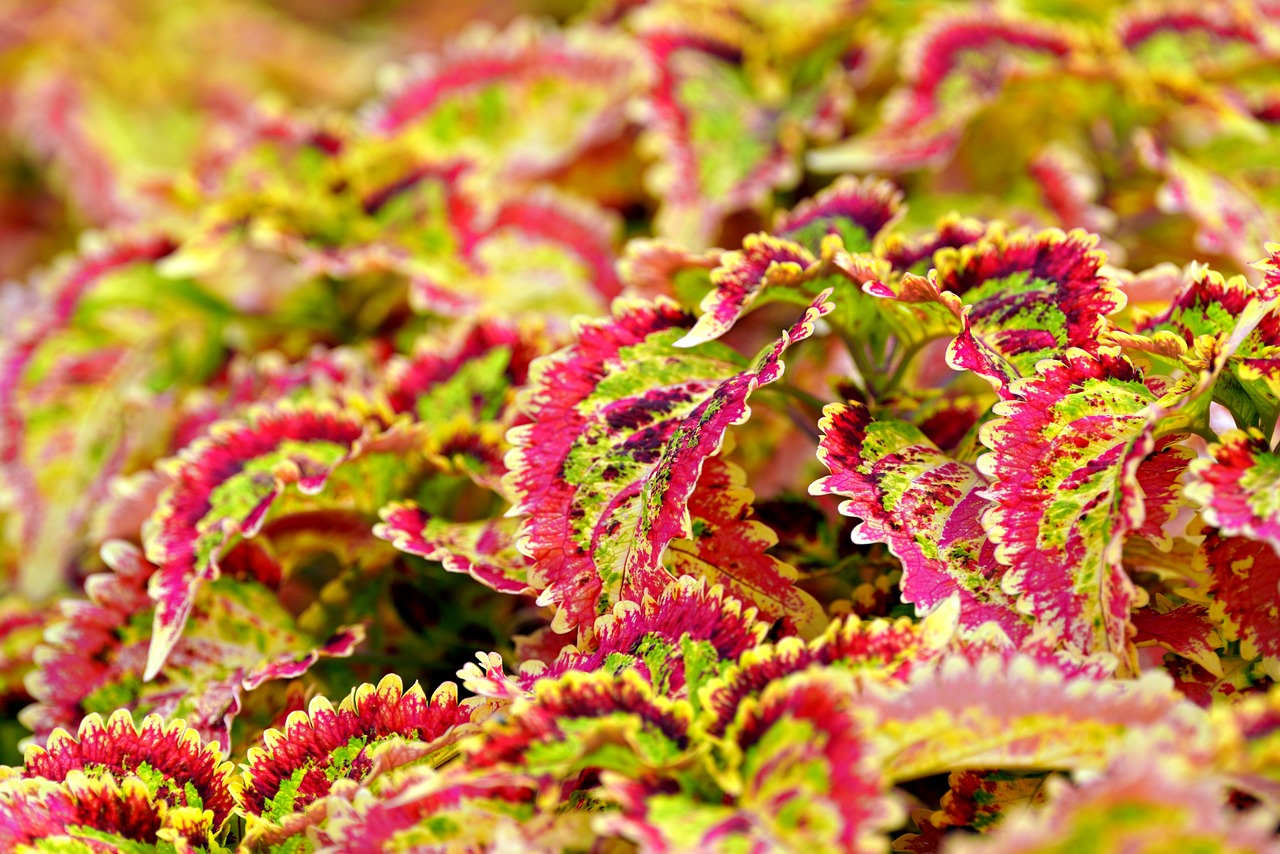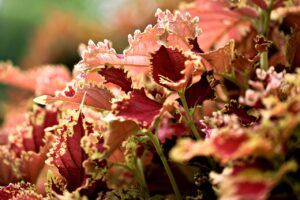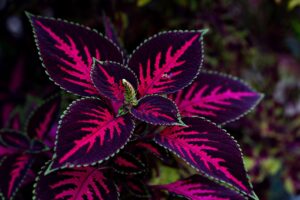Coleus
Overview
The Coleus herb, or Plectranthus scutellarioides, is renowned for its ornamental variegated leaves, displaying a variety of vibrant colors. Native to Southeast Asia, this member of the Lamiaceae family is commonly grown in gardens or as a decorative houseplant, cherished since Victorian times for its striking foliage.
Growing Conditions
- Partial to full shade preferred.
- Thrives in rich, moist, and well-drained soil.
- Optimal soil pH: 6.0 – 7.0.
Uses and Benefits
Coleus is valued primarily for its visual appeal in home and garden decor.
Cultivation Tips
- Can reach up to 24-30 inches in height and width.
- Hybrid strains offer a wide range of leaf coloration.
Seasonal Considerations
Flowers seasonally in appropriate climates.
Common Issues
Note: May become invasive in some regions.
History and Folklore
Esteemed since the Victorian era, with origins in Southeast Asia.

Characteristics
Known for its vibrant, variegated foliage and versatility as both a houseplant and garden ornamental.
Region
Southeast Asia and Malaysia; cultivated worldwide in suitable climates.
Natural Habitat
Southeast Asian and Malaysian forests.
Cultivation
Prefers part to full shade; requires rich, moist, well-drained soil; thrives in slightly acidic to neutral pH (6.0-7.0).
Uses and Benefits
Coleus, or Plectranthus scutellarioides, presents multiple uses beyond its striking aesthetics. Firstly, it’s admired as a vibrant accent in home and garden spaces, adding a splash of color where other plants may not thrive due to shade conditions2.
- Acts as a beautiful, living piece of decor with its variegated magenta and green leaves.
- Makes an excellent choice for container gardening and indoor plant arrangements.
- Can be easily propagated, allowing gardeners to share and multiply their collection.
- Useful in shaded gardens where few other plants can flourish, making the most of limited light.
Additionally, its easy cultivation and maintenance make it a favorite among beginner and expert gardeners alike5. However, in certain regions, mindful planting is essential as it can become invasive4.

Cultivation Tips
Growing a healthy Plectranthus scutellarioides, or Coleus, contributes a vibrant splash of color to your home or garden. Here are cultivation tips to help your Coleus thrive:
- Light: Coleus plants flourish in partial shade to full shade. If growing indoors, a north-facing window is ideal.
- Soil: Aim for rich, moist, and well-draining soil. The soil pH should be slightly acidic to neutral (6.0 to 7.0).
- Watering: Keep the soil consistently moist but not waterlogged. Water the plant when the top inch of soil feels dry to the touch.
- Temperature: Coleus prefers warmer climates and should be protected from temperatures below 50°F (10°C).
- Feeding: Feed with a balanced, water-soluble fertilizer every two weeks during the growing season.
- Spacing: For a dense display, space your Coleus about 10 to 14 inches apart.
- Pruning: Pinch back the growing tips to encourage bushiness and remove flowering stalks to focus energy on foliage production.
Be watchful for
Seasonal Considerations
Seasonal considerations are key to maintaining the vibrant appearance of the Plectranthus scutellarioides, commonly known as the Coleus plant. This herbaceous perennial, often grown as an annual, has specific blooming times influenced by the time of year.
- In spring, initiate Coleus planting after the threat of frost has passed.
- Summer provides optimal growth conditions; ensure there’s adequate moisture and partial shade.
- As fall approaches, prepare Coleus for cooler temperatures, which can stunt growth or cause damage.
- During winter, in non-tropical climates, bring Coleus indoors to protect it from cold temperatures.
Proper timing ensures your Coleus remains healthy and displays its ornamental leaves throughout its growing season5.

Issues and Troubleshooting
Common Issues with Coleus Plants and Troubleshooting
Coleus (Plectranthus scutellarioides), while generally easy to grow, can encounter several problems:
- Excess sunlight: Leaves may fade if exposed to too much light. Ensure the plant receives partial to full shade for vibrant foliage.
- Overwatering: Root rot can develop in soggy soil. Water only when the top inch of soil is dry.
- Pest Infestations: Watch for common pests such as spider mites and mealybugs. Remove pests manually or use insecticidal soap.
- Invasive Growth: In certain areas, Coleus can become invasive4. Regular pruning and monitoring will help control its spread.
By monitoring and adjusting care practices, these issues can be easily managed to maintain healthy, decorative Coleus plants in your home and garden.
History and Folklore
The enchanting Coleus, known scientifically as Plectranthus scutellarioides, has a storied past that stretches back to the lush landscapes of Southeast Asia and Malaysia. In the vitamin-rich soil of these tropical regions, the Coleus emerged as a botanical jewel with variegated leaves that captivate the eye. By Victorian times, this plant had woven itself into the fabric of ornamental gardening and became a staple in homes and gardens far beyond its native realm12.
While not the subject of extensive folklore, the reputation of Coleus as an emblem of beauty during the Victorian era speaks to its longstanding allure and the human desire to surround ourselves with vibrant foliage.
References
1. “Plectranthus scutellarioides – Plant Finder – Missouri Botanical Garden.” https://www.missouribotanicalgarden.org/PlantFinder/PlantFinderDetails.aspx?kempercode=a547
2. “Coleus | Foliage Plant, Ornamental & Perennial | Britannica.” https://www.britannica.com/plant/coleus
3. “Coleus scutellarioides – Wikipedia.” https://en.wikipedia.org/wiki/Coleus_scutellarioides
4. “Plectranthus scutellarioides (coleus) | CABI Compendium.” https://www.cabidigitallibrary.org/doi/10.1079/cabicompendium.118545
5. “Coleus Plants: Care & Growing Guide – The Spruce.” https://www.thespruce.com/how-to-grow-coleus-plants-1402921
Image Credit: ignartonosbg
Image Credit: ignartonosbg
Image Credit: ignartonosbg
Nicolas Duval
Nicolas is a passionate advocate for nature and the art of wildcrafting. His dedication shines through in Wildcraftia, a website he meticulously crafted to serve as a haven for nature enthusiasts worldwide. Driven by a deep appreciation for nature’s connection to humanity, Nicolas embarked on his journey in 2011 with SmokableHerbs, a platform showcasing his love for nature’s bounty. Building upon this foundation, he established Smokably, a thriving online store offering premium herbs and blends to a global audience.
